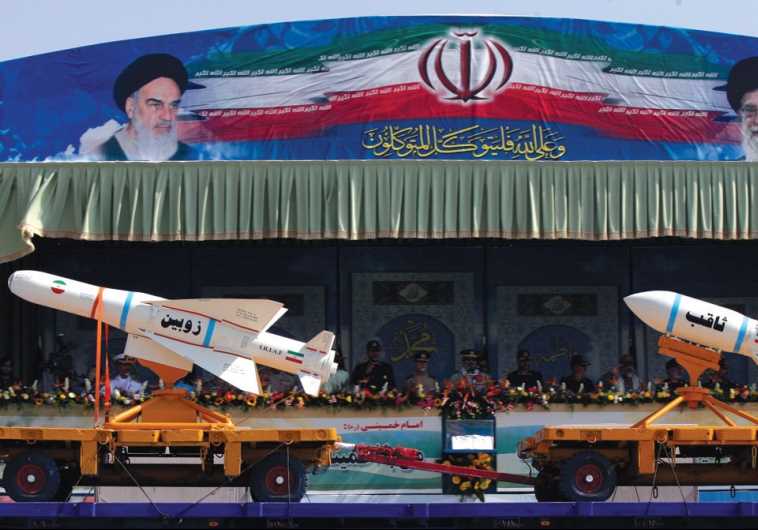
Iran Broadcasts Footage of Underground Missile Base
Agence France Presse/Naharnet/October 14/15/Iranian state television broadcast unprecedented footage Wednesday of a deep underground tunnel packed with missiles and launcher units, which officials said could be used if “enemies make a mistake”. The pictures were released just three days after Iran tested a new long-range missile that the United States said may have breached a U.N. Security Council resolution. The footage also came a day after Iran’s parliament approved the country’s July 14 nuclear deal with six world powers. Iranian officials have said the nuclear agreement will not affect its military forces, particularly its ballistic missile program. The missile launch and underground footage followed pressure from lawmakers to prove the military had not been weakened by the deal. The tunnel, hundreds of meters (yards) long and about 10 meters high, was filled with missiles and hardware. Brigadier General Amir Ali Hajizadeh, commander of the Islamic Republic’s Revolutionary Guards’ aerospace division, said numerous such tunnels exist across the country at a depth of 500 meters. “The Islamic republic’s long-range missile bases are stationed and ready under the high mountains in all the country’s provinces and cities,” he said, according to the Guards’ website. The commander said the missiles were ready to be launched from all over Iran, on the order of “the supreme commander-in-chief”, Ayatollah Ali Khamenei. “This is a sample of our massive missile bases,” he said, adding that “a new and advanced generation of long-range liquid and solid fuel missiles” would start to replace the current weapons next year. The commander seemed to suggest the show of strength was in response to Western powers, especially the U.S., which despite the nuclear deal, have said options against Iran, including the military one, remain on the table. “Those who pin hope on options on the table, should only have a look at the Islamic republic’s army options under the table.”Hajizadeh said Iran would not start any war but “if enemies make a mistake, missile bases will erupt like a volcano from the depth of earth.”The U.S. on Tuesday said Tehran may have breached a Security Council resolution during Sunday’s test of the new Imad missile. White House spokesman Josh Earnest said there were “strong indications” that Tehran “did violate U.N. Security Council resolutions that pertain to Iran’s ballistic missile activities.”Under a resolution passed days after the nuclear deal was reached, Iran was barred by the Security Council from developing missiles “designed to carry nuclear warheads.”However the White House insisted the launch would have no impact on the nuclear agreement which is due to be formally implemented by the end of this year.
US: Iran likely violated international missile laws
J.Post/October 15/15/WASHINGTON – Iran has probably broken international laws against its experimentation with ballistic missile technology, the White House said. “We’ve got strong indications that those missile tests did violate a UN Security Council resolution that pertain to Iran’s ballistic missile activities. Unfortunately, that’s not new,” White House press secretary Josh Earnest told reporters on Tuesday. “We have seen Iran almost serially violate the international community’s concerns about their ballistic missile program. And the UN Security Council resolution actually gives the international community some tools to interdict some equipment and material that could be used to advance their ballistic missile program.”Earnest was referring to a UN resolution prohibiting Iran from pursuing ballistic missiles that can deliver nuclear warheads. But Iran has called the resolution illegal, and has long vowed to ignore it. Certain types of missiles, specifically intercontinental ballistic missiles, are designed for nuclear and not conventional military uses. They breach the atmosphere and speedily reenter over an intended target, are fashioned to carry the unique payload of a nuclear warhead and are not designed as precision weapons, given the nature of the intended strike. “This is altogether separate from the nuclear agreement that Iran reached with the rest of the world,” Earnest said. The Iran nuclear deal reached on July 14, formally known as the Joint Comprehensive Plan of Action, lifts international restrictions on Iran’s ballistic missile program after eight years. At the State Department, a spokesman said the US would pursue punitive action against Iran within the parameters of the existing UN Security Council resolution, but not new sanctions.
Iranian stocks continue two-year slump
Morteza Ramezanpour/Al Monitor/October 14/15
TEHRAN, Iran — Lingering ambiguities, cuts in company earnings, high interest rates, stubborn inflation and Western sanctions have combined to send the Tehran Stock Exchange’s TEDPIX to its lowest point in over two years. According to Tehran Stock Exchange data, TEDPIX has been extending its monthslong rout, and is now hovering just above the 61,000 mark. Broad sell-offs, particularly in the important automotive sector amid negative adjustments in biannual company reports, have greatly contributed to the latest downturn. The TSE benchmark had gained some 6% in anticipation of a comprehensive nuclear deal between Iran and six world powers during the Iranian month that ended July 22. However, once the deal was clinched on July 14, the bubble burst. Accumulated gains gradually evaporated, stirring further concern among both retail and institutional investors. The benchmark TEDPIX tumbled over 4% last month, and a total of almost 12% since the nuclear deal was struck. The gloom currently hanging over Iran’s cash-strapped economy is broad, and encompasses many leading indicators. Mounting pain from falling commodity prices, the high level of nonperforming loans — estimated at up to $60 billion — the budget deficit of potentially 3.8% for the current Iranian year (which began March 21, 2015), the high rate of return being offered by banks and lingering sanctions are ensuring a bleak short-term outlook for the Iranian economy.
Oil and gas as well as petrochemicals dominate equity markets. Jointly, these sectors account for 38% of total market capitalization. They are followed by metals and minerals as well as the financial sector, which respectively account for 20% and 16% of market capitalization. Hence, any jitters in these sectors quickly rattle the market as a whole.
Among the many uncertainties, mining royalties, which have always been a subject of heated debate in the country, are weighing down the important mining sector. This industry has already been severely hit by China’s economic slowdown and the sanctions on Iran. Now, there are increasingly loud calls for a cut in the current 25% mining royalty, even though this would diminish the revenues of the government, which is already reeling from tumbling oil prices. About $550 million were to be collected in mining royalties in the current Iranian year. However, the amount has been reduced to $90 million following negotiations between parliament and Cabinet officials, said Jafar Sargini, the deputy minister of industries, mining and trade. Of note, the long-term royalty rate has not yet been fixed. Furthermore, ever-increasing ambiguities regarding feedstock prices are painting a hazy outlook for the significant petrochemical sector and pushing investors to the edge. Major Iranian petrochemical complexes are striving to convince the government to reduce feedstock prices and fix them for a 10-year period — currently 13 cents per cubic meter — in an effort to make the sector much more lucrative for foreign investors and help its performance. Iran is seeking almost $85 billion in foreign investment to overhaul its petrochemical industry. The looming rebound in oil prices along with feedstock price ambiguities are ratcheting up pressure mainly on shareholders.
Meanwhile, high interest rates for bank deposits are hanging over the stock market. In a bid to offset stock market losses or to cope with the pace of inflation, investors are fleeing to the safe haven of risk-free bank deposits and fixed-income instruments, including Islamic bonds — sukuk — and the newly debuted Islamic treasury bills. Given the situation, listed companies are feeling the pinch amid a strongly bearish sentiment. Also, the global commodities glut has dramatically diminished listed companies’ earnings in Iran’s export-oriented stock market. “Investment companies and funds are deleveraging and money is moving from equities to fixed-income instruments,” Reza Soltanzadeh, CEO of Iran Industries Investment Company, told Al-Monitor:
Many state-owned commercial lenders are in an alarming state, as they hold high levels of toxic debt in their balance sheets. To replenish depleted resources, they have no choice except to lure investors with high interest rates, which can help them survive, Hossein Abdo Tabrizi, a member of the High Council of Exchange Market Representatives, told Al-Monitor. “Slashing the interest rate is a significant step to pique investors’ attention and send them back into the equity market,” Abdo Tabrizi said. He further elaborated that pension funds used to be the chief liquidity providers in the equity market. However, they now experience more cash outflows than inflows, which is pressuring them to dump shares instead of shoring up portfolios. When President Hassan Rouhani took office in August 2013, his economic team was geared to manage the rising liquidity issue in a bid to tame stubborn inflation. Hence, interest rates for bank deposits went up to swallow the liquidity. Money flocked to the banks as a safe haven for investments, with up to 25% in annual interest. This policy has been successful in terms of subduing inflation. However, it has been accompanied by a persistent liquidity drain in the equity market.
The credit crunch has ultimately curbed investors’ enthusiasm about shoring up their portfolios and triggered sell-offs in the stock market, Mehdi Naji, a senior market analyst at Hafez brokerage, told Al-Monitor. “The money market is offering a risk-free investment with 25% yield annually, though the equity market’s yield since the beginning of the current Iranian year has been even below zero with an average P/E ratio at almost five.”The TSE, which has a market capitalization of close to $91 billion, has also seen its daily trade volume take a hit from the recent commodities glut. Daily trade volume used to be almost $90 million; however, the cloud of pessimism drove daily trade volume down to $20 million in the last week of September. Yet, despite the dark clouds, the Iranian economy is expected to experience a positive momentum by early 2016, when major Western sanctions are to be removed. Fresh stimulus, including foreign direct investment and repatriation of frozen assets abroad, are seen as likely to trigger a persistent upward trend at the stock market. However, until then, uncertainty appears set to continue at the Tehran Stock Exchange.





















